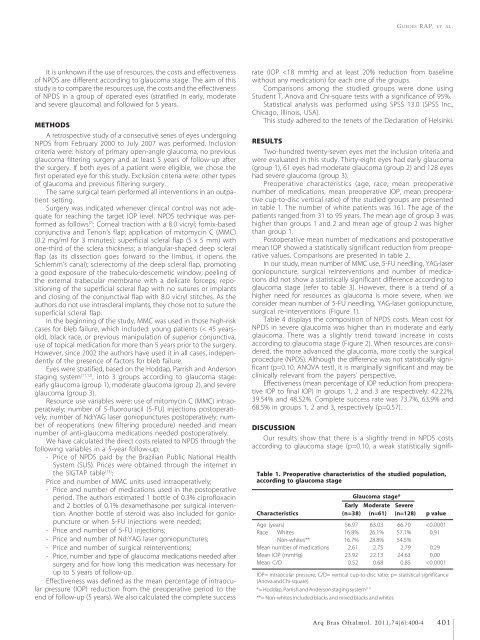Cost and effectiveness of non-penetrating deep sclerectomy ...
Cost and effectiveness of non-penetrating deep sclerectomy ...
Cost and effectiveness of non-penetrating deep sclerectomy ...
Create successful ePaper yourself
Turn your PDF publications into a flip-book with our unique Google optimized e-Paper software.
GUEDES RAP, ET AL.<br />
It is unknown if the use <strong>of</strong> resources, the costs <strong>and</strong> <strong>effectiveness</strong><br />
<strong>of</strong> NPDS are different according to glaucoma stage. The aim <strong>of</strong> this<br />
study is to compare the resources use, the costs <strong>and</strong> the <strong>effectiveness</strong><br />
<strong>of</strong> NPDS in a group <strong>of</strong> operated eyes (stratified in early, moderate<br />
<strong>and</strong> severe glaucoma) <strong>and</strong> followed for 5 years.<br />
METHODS<br />
A retrospective study <strong>of</strong> a consecutive series <strong>of</strong> eyes undergoing<br />
NPDS from February 2000 to July 2007 was performed. Inclusion<br />
criteria were: history <strong>of</strong> primary open-angle glaucoma, no previous<br />
glaucoma filtering surgery <strong>and</strong> at least 5 years <strong>of</strong> follow-up after<br />
the surgery. If both eyes <strong>of</strong> a patient were eligible, we chose the<br />
first operated eye for this study. Exclusion criteria were: other types<br />
<strong>of</strong> glaucoma <strong>and</strong> previous filtering surgery.<br />
The same surgical team performed all interventions in an outpatient<br />
setting.<br />
Surgery was indicated whenever clinical control was not adequate<br />
for reaching the target IOP level. NPDS technique was performed<br />
as follows (7) : Corneal traction with a 8.0 vicryl; fornix-based<br />
conjunctiva <strong>and</strong> Te<strong>non</strong>’s flap; application <strong>of</strong> mitomycin C (MMC)<br />
(0.2 mg/ml for 3 minutes); superficial scleral flap (5 x 5 mm) with<br />
one-third <strong>of</strong> the sclera thickness; a triangular-shaped <strong>deep</strong> scleral<br />
flap (as its dissection goes forward to the limbus, it opens the<br />
Schlemm’s canal); <strong>sclerectomy</strong> <strong>of</strong> the <strong>deep</strong> scleral flap, promoting<br />
a good exposure <strong>of</strong> the trabeculo-descemetic window; peeling <strong>of</strong><br />
the external trabecular membrane with a delicate forceps; repositioning<br />
<strong>of</strong> the superficial scleral flap with no sutures or implants<br />
<strong>and</strong> closing <strong>of</strong> the conjunctival flap with 8.0 vicryl stitches. As the<br />
authors do not use intrascleral implants, they chose not to suture the<br />
superficial scleral flap.<br />
In the beginning <strong>of</strong> the study, MMC was used in those high-risk<br />
cases for bleb failure, which included: young patients (< 45 yearsold),<br />
black race, or previous manipulation <strong>of</strong> superior conjunctiva,<br />
use <strong>of</strong> topical medication for more than 5 years prior to the surgery.<br />
However, since 2002 the authors have used it in all cases, independently<br />
<strong>of</strong> the presence <strong>of</strong> factors for bleb failure.<br />
Eyes were stratified, based on the Hoddap, Parrish <strong>and</strong> Anderson<br />
staging system (11,12) , into 3 groups according to glaucoma stage:<br />
early glaucoma (group 1), moderate glaucoma (group 2), <strong>and</strong> severe<br />
glaucoma (group 3).<br />
Resource use variables were: use <strong>of</strong> mitomycin C (MMC) intraoperatively;<br />
number <strong>of</strong> 5-fluorouracil (5-FU) injections postoperatively;<br />
number <strong>of</strong> Nd:YAG laser goniopunctures postoperatively; number<br />
<strong>of</strong> reoperations (new filtering procedure) needed <strong>and</strong> mean<br />
number <strong>of</strong> anti-glaucoma medications needed postoperatively.<br />
We have calculated the direct costs related to NPDS through the<br />
following variables in a 5-year follow-up:<br />
- Price <strong>of</strong> NPDS paid by the Brazilian Public National Health<br />
System (SUS). Prices were obtained through the internet in<br />
the SIGTAP table (13) ;<br />
Price <strong>and</strong> number <strong>of</strong> MMC units used intraoperatively;<br />
- Price <strong>and</strong> number <strong>of</strong> medications used in the postoperative<br />
period. The authors estimated 1 bottle <strong>of</strong> 0.3% cipr<strong>of</strong>loxacin<br />
<strong>and</strong> 2 bottles <strong>of</strong> 0.1% dexamethasone per surgical intervention.<br />
Another bottle <strong>of</strong> steroid was also included for goniopuncture<br />
or when 5-FU injections were needed;<br />
- Price <strong>and</strong> number <strong>of</strong> 5-FU injections;<br />
- Price <strong>and</strong> number <strong>of</strong> Nd:YAG laser goniopunctures;<br />
- Price <strong>and</strong> number <strong>of</strong> surgical reinterventions;<br />
- Price, number <strong>and</strong> type <strong>of</strong> glaucoma medications needed after<br />
surgery <strong>and</strong> for how long this medication was necessary for<br />
up to 5 years <strong>of</strong> follow-up.<br />
Effectiveness was defined as the mean percentage <strong>of</strong> intraocular<br />
pressure (IOP) reduction from the preoperative period to the<br />
end <strong>of</strong> follow-up (5 years). We also calculated the complete success<br />
rate (IOP

















